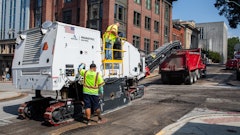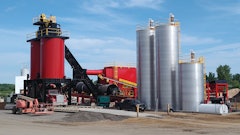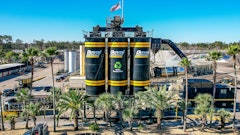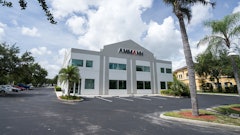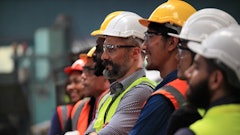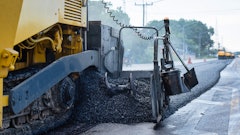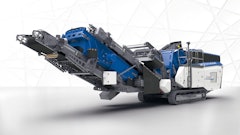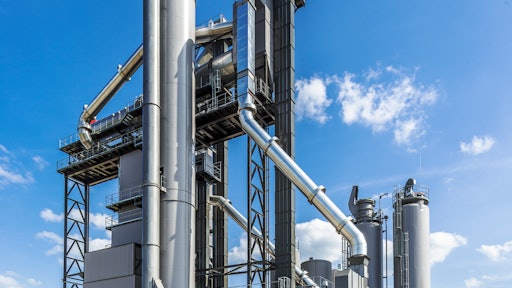
At the start of the New Year, Asphalt Contractor asked Ammann a series of questions on the company’s sustainability technology, increased RAP utilization and what’s in store for 2022 and beyond, particularly in the U.S.
Q --- Ammann has been in the forefront of sustainability in asphalt production for quite some time. A huge part of that is the ability for customers and clients to use a high percentage of recycled material in their mix while still maintaining the same high level of strength, reliability and longevity found using virgin material.
A --- It’s essential that asphalt producers have both recycling capabilities and practicality.
We must provide recycling opportunities while never, ever sacrificing quality. That’s our focus at Ammann. Our asphalt-mixing plants are world renowned for their performance, efficiency, high-quality mix output – and innovative recycling processes.
Our customers are on the record as saying that the recycled mix produced by Ammann asphalt plants has quality that surpasses their expectations – and the expectations of their customers, too. These end-users say it’s better than mix made with 100% virgin aggregate.
Of course, RAP utilization provides significant cost savings. Industry leaders increasingly see green practices as not only a way to better the world, but a tactic to improve profitability, too.
The longevity of the Ammann recycled mix is exceptional. We’ve been doing this for a long time, all around the world, and the recycled mixes monitored by governmental agencies actually last longer than mix with purely virgin aggregate.
One other point on practicality … we offer both batch and continuous plants to ensure our customers have the configuration they’re most comfortable with.
Q --- I think in the past 40% was an attainable goal for many, but I understand Ammann can go well beyond that level today. Where does that attainable level stand now and are more producers upping that use of reclaimed material?
A --- There needs to be an overall focus on practicality in this area, too. We have a plant that produces high-quality mix with 100% recycled materials. But we also have options for lower percentages of RAP utilization.
The RAH60 is a parallel flow dryer where up to 60% hot recycled materials can be fed. The RAH50 is a middle-ring dryer that incorporates up to 40% recycled materials.
Recycling can also occur at Ammann Asphalt-Mixing Plants that do not employ these specific dryers. Up to 30% cold recycled material can go directly into the mixer, meaning any plant from Ammann is capable of utilizing that percentage of RAP.
Q --- Are there any quantifiable numbers, percentages and/or thoughts on how RAP has continued to be so beneficial in cost savings and environmentally sound practices in road construction, say now versus 5, 10, or more years ago?
A --- Increased use of RAP improves the bottom line. Every percentage increase means that much less is spent on virgin aggregate. Ammann has gentle heating processes as well, which minimizes fuel needs.
What has changed in the last decade is more RAP utilization. At Ammann we have a global view. What we’ve seen around the world is governmental agencies requiring some RAP usage – and then customers being amazed by the quality and value it brings. It doesn’t take long before these customers start using higher percentages of RAP – without governmental prompting.
Q --- With the rising interest in ‘green’ initiatives, do you find that state DOTs are showing greater interest going forward in allowing increased RAP and other environmentally friendly methods?
A --- DOTs are showing greater interest, though of course that varies from one state to another. Overall, there was some initial hesitancy about the quality and longevity. That slowly but surely is diminishing. Plant owners will likely push this movement forward because of the cost savings they are starting to realize.
Q --- Are there retrofit advancements that you offer for producers unwilling to invest in an entirely new facility, especially if they serve in areas where DOT RAP restrictions are currently in place? In such cases, is it possible for a retrofit to be a ‘bridge’ to more use of RAP in the mix if (and when) state agencies adopt more sustainable guidelines for road construction?
Asphalt producers might be surprised by how much they can accomplish with their existing plant. A retrofit costs a fraction of the price of a new plant and is compatible with products made by Ammann and other manufacturers.
A retrofit has a host of options you can choose from, including recycling solutions. A retrofit enables the use of foam bitumen, waxes and other additives. Special bitumen and alternative mixing cycles can be utilized as well.
The plant owner can determine the level of the commitment. Many retrofit customers incorporate a new dryer, which optimizes heat transfer – and of course reduces emissions – and enables the employment of an expanded range of materials, including RAP.
A retrofit can include environmental upgrades to the bitumen tank and baghouse. It can incorporate noise reduction solutions, too. A host of technological improvements can be made – including revamped burners, mixers and the control system.
Also … Ammann plants are engineered for easy integration of future options and technologies such as enhanced use of additives, fibers and more recyclable materials. Retrofits provide these benefits, too. You won’t just be up to date today – but tomorrow, too.
Q --- Have producers and agencies in any U.S. states been in the forefront of increased recycled content in asphalt mix along with other environmental initiatives (neighborhood noise reduction, emission controls other green methods)?
A --- A shortage of industrial land means that asphalt plants increasingly must be located closer to residential areas. Local governments can have very strict standards when it comes to noise, so we have to make the plants as quiet as possible.
Ammann has been very proactive on this front. We offer varied sound-suppression packages to meet our customers’ specific needs. Some customers need to lower sound a bit, while others have to take more substantial measures. The efforts start with equipping burners with variable speed motor drives, which are much quieter, and stack silencers, which control exhaust noise. We offer more and more sound-suppression options, all the way to cladding the entire plant.
That cladding, by the way, makes the plants look like commercial buildings. They are beautiful facilities that fit nicely in urban office parks. Passersby would never guess there is an asphalt-mixing plant inside.
Regarding dust … Ammann Asphalt-Mixing Plants remove dust through a highly efficient baghouse filter. It actually lowers exhaust dust to less than 0.0044 gr/ft3, which is an exemplary benchmark. We are currently working on reducing this value significantly again, to < 0.0022 gr/ft3.
We focus on dust reduction points for further improvement. Taking measures at the cold feeder, load-out, skip hood, overflow silo, filler loading area, screen, belts and transfer points makes a big difference. That’s in addition to the efforts provided through the baghouse.
Regarding emissions … The biggest reductions in indirect CO2 emissions result from the implementation of RAP. I would say the main focus is on trimming CO2, VOCs and NOx in the combustion process and on reducing the residual dust content after the baghouse.
We continually work to reduce CO₂ emissions. This can be accomplished by actively cooling the drum, increasing drying efficiency and utilizing energy sources such as biofuels and wood dust. Ammann technology can diminish CO₂ by 10% or even considerably more, depending on the age of the plant and the technology chosen.
There are other somewhat hidden opportunities to trim CO2 emissions, including the bitumen tank farm. A traditional farm consists of horizontal tanks heated with thermal oil. Changing to an electrically heated, vertical tank farm results in considerable advantages. There is no oil consumption and therefore no emissions. Electric heating is cost-effective, too. In fact, electrically heated bitumen tanks have become standard in all of Europe and other parts of the world.
Warm-mix asphalt is another opportunity that is becoming more prevalent. While conventional asphalt is produced at around 338°F, the low temperature processes of today allow production temperatures of around 212°F. Lowering the manufacturing temperature eases energy needs, and therefore emissions, too.
Q --- Ammann’s ABP HRT recycling system is arranged vertically, in direct line above the mixer. Can you tell me the advantage gained through this method? Are you the only ones using this method in plant development? What has been the reaction among asphalt producers, particularly here in the U.S.?
A --- The ABP HRT plant is designed around the incorporation of large percentages of RAP. What you see with the vertical stacking is a nod to the fact that the HRT plant has elevated RAP from a supporting role to the lead actor. The vertical stacking is unique to Ammann.
As you stated, the most striking difference is that the ABP HRT’s entire recycling system is arranged vertically, in direct line above the mixer. This allows materials to be dropped instead of conveyed, which minimizes wear and optimizes transport of the hot RAP. The HRT approach also means that there is enough room in the plant’s tower for additive feed components and for carrying out inspection and maintenance work.
Q --- From articles I’ve read, it appears that the U.S., although very environmentally conscious, still lags behind many other countries when it comes to increasing RAP percentages in asphalt mix. Is that a true statement and, if so, do you see that changing dramatically over the next few years especially with the focus now on infrastructure development, an area that some say has been sorely needed around the country?
A --- Many countries that did not initially adopt recycling are now moving ahead rather quickly. China is an example of this. The country is leveraging some of Ammann’s most advanced recycling plants and creating mix with extremely high percentages of RAP.
The earlier adopters are now recycling even more. That can result from governments lifting restrictions, but increasingly it’s because the asphalt producers see the value of RAP.
The U.S. has lagged behind some countries, particularly those in Europe. But recycling is starting to be emphasized more here and we expect it to grow exponentially.
Q --- Ammann has been very active in asphalt production capabilities and technologies since the mid 19th century and to this day is a key, or THE key player, in so many international markets. You have a presence in the U.S. with a base in Florida. Are there plans afoot to expand the U.S. footprint in 2022 and beyond?
A --- Ammann is very focused on improving the areas of Cost, Quality, and Delivery for our customers in every region of the world. We are driving sustainable growth in North America and are always evaluating the potential for making additional investments / expansions to properly serve the North America Market. I do not want to give away too much information in this area, but the base in Florida will not be the final view of Ammann America.
Q --- Ammann maintains a patented ‘zero waste system’ in continuous plants. How does that work and what are the key quantifiable benefits?
A --- With continuous asphalt-mixing plants, the first and last few tonnes of every shift are waste.
An Ammann team of experts developed a patented solution that ensures all mix has the proper percentage of larger aggregates and fines from the very start to the very end. The creative solution prevents up to 5 tonnes of mix per plant per shift from going into the scrap pile – every day.
Q --- As a technological leader in asphalt plants and related machinery, without giving up corporate secrets, are there some new innovation(s) on the horizon for introduction in 2022 and in ensuing years? Similarly, are there any new services that Ammann plans to offer asphalt producers here in the U.S. in 2022?
A --- The use of new fuels is a continued focus. We are taking renewable energy sources or, in some cases, converting a waste product into fuel. This conserves natural resources and puts less pressure on landfills.
Biofuels are one initiative. Examples of these fuels are rapeseed and sugar cane. Tall oil, which is a waste product of cellulose sulphate production, can be used, too. Utilization of any of these energy sources lessens reliance on more traditional fossil fuels.
Ammann biofuel burners can also utilize more traditional fuels such as natural gas, LPG, light and heavy oil and kerosene. This alleviates the concerns of customers who are hesitant to rely solely on newer fuels.
On the renewable front, we are very high on the wood dust burner. The burner transforms wood dust, a material that is available from local sources, into a renewable fuel. What makes this dust burner even more exceptional is its carbon neutrality. The carbon dioxide released when burning wood is offset by the fact the tree consumed that amount of carbon dioxide during its life. Therefore, this part of the emissions is carbon-neutral.
The burner has proven effective and is used on a number of Ammann Asphalt-Mixing Plants. It can be retrofitted on existing plants as well.
We expect that in the near future other fuel types such as hydrogen will significantly reduce gas emission values. These fuels will also be much more important in our industry. Ammann is already working on solutions to be prepared for this.
Q --- Ammann produces a wide variety of options for large and smaller plants and even those that fit into tight spaces. Which option has been the most popular one in recent years and which seems to be attracting more attention going forward in the 2022-25 period?
A --- Ammann plants have footprints of varied sizes, with some exceptionally small. Plants can still be productive, even in the smallest of spaces.










